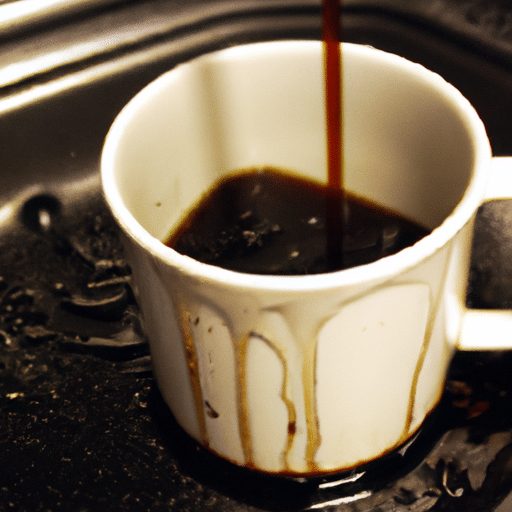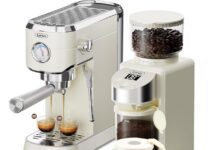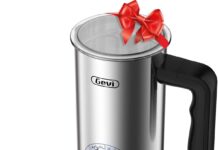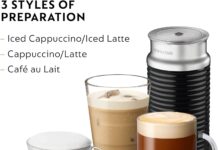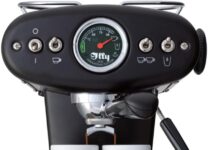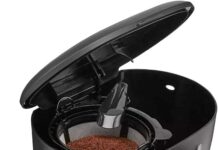You wake up early in the morning, craving that first sip of freshly brewed coffee. As you eagerly press the start button on your trusty coffee maker, excitement quickly turns into dismay as you watch the hot brown liquid overflow and create a mess on your countertop. It’s a frustrating and all-too-common problem that many coffee lovers have experienced. But fear not, dear reader, for in this article, we will unravel the mysteries behind why your coffee maker overflows and provide you with simple solutions to prevent this messy morning mishap.
Possible causes of coffee maker overflow
Improper coffee grounds measurement
When it comes to making the perfect cup of coffee, precision is key. Using too many coffee grounds can lead to an overflow in your coffee maker. The excess coffee grounds can clog the filter, preventing the water from passing through properly, and causing the overflow. To prevent this, make sure to follow the recommended measurement guidelines provided by your coffee maker manufacturer.
Clogged filter
Another common cause of coffee maker overflow is a clogged filter. Over time, coffee oils and residue can build up in the filter, restricting water flow and causing an overflow. Regularly cleaning and maintaining the filter is essential to prevent this issue. Depending on your coffee maker, the filter may be removable and washable, or it may require periodic replacement.
Excessive water in the reservoir
Pouring too much water into the reservoir can lead to an overflow. Coffee makers have a maximum water capacity, and exceeding this limit can cause the water to overflow when the brewing process starts. It is important to always check the water level and ensure it is within the recommended range before brewing your coffee. This simple step can help prevent overflow and potential damage to your coffee maker.
Malfunctioning water level sensor
Coffee makers are equipped with a water level sensor that detects the amount of water in the reservoir. If this sensor malfunctions, it may incorrectly detect the water level, leading to an overflow. If you consistently experience overflow despite accurately measuring the water, it is possible that the water level sensor is faulty. In such cases, contacting the manufacturer or a technician for repair or replacement is recommended.
Incorrect brewing settings
Each coffee maker has specific brewing settings that determine the water temperature, brewing time, and other factors. If these settings are incorrect or improperly adjusted, it can result in an overflow. It’s important to familiarize yourself with your coffee maker’s brewing settings and ensure they are correctly configured. Refer to the user manual or contact the manufacturer for guidance on adjusting the brewing settings if needed.
Effects of coffee maker overflow
Wasted coffee and money
One of the most obvious effects of a coffee maker overflow is the waste of coffee and money. When your coffee maker overflows, some or all of the brewed coffee ends up outside the carafe or mug. This not only leads to a loss of coffee, but also the wasted money spent on the coffee grounds and the energy used to brew it. By preventing overflow, you can ensure that every drop of delicious coffee ends up in your cup.
Messy cleanup and potential damage
Overflowing coffee can create quite a mess, requiring additional time and effort for cleanup. The coffee can spill onto the countertops, floors, or even electrical components of the coffee maker. This can not only be messy but also potentially damaging to the machine. Coffee can seep into the internal components, causing them to malfunction or deteriorate over time. By preventing overflow, you can avoid the hassle of cleaning up a coffee mess and reduce the risk of damage to your coffee maker.
Inconsistent brewing results
Coffee maker overflow can also result in inconsistent brewing results. When the water overflows, it may not fully extract the flavors from the coffee grounds, leading to a weaker or less flavorful cup of coffee. Inconsistent brewing can be frustrating, especially when you’re looking forward to that perfect cup to start your day. By addressing the causes of overflow, you can ensure a consistent and satisfying brewing experience every time.
Safety hazards
Coffee maker overflow can pose safety hazards, especially if the coffee spills onto electrical components. This can potentially lead to electrical shocks, short circuits, or other electrical hazards. Additionally, if the overflowing coffee comes into contact with a hot surface, it can cause burns or scalding. Ensuring that your coffee maker doesn’t overflow is not only for the sake of convenience and taste, but also for your safety and the safety of those around you.
How to prevent coffee maker overflow
Properly measure coffee grounds
To prevent coffee maker overflow, it’s crucial to measure the coffee grounds accurately. Refer to the user manual or the coffee maker manufacturer’s instructions for the recommended coffee-to-water ratio. Using a kitchen scale or a coffee scoop with clear measurements can help ensure you’re using the right amount of coffee grounds. By measuring the coffee grounds properly, you can avoid the risk of overflow caused by excessive grounds clogging the system.
Regularly clean and maintain the filter
Cleaning and maintaining the filter is essential for preventing coffee maker overflow. Depending on the type of filter, it may need to be cleaned or replaced regularly. If your coffee maker has a removable and washable filter, rinse it thoroughly to remove any coffee residue and oils. For filters that need to be replaced, follow the manufacturer’s instructions for the recommended replacement schedule. By keeping the filter clean and in good condition, you can ensure proper water flow and prevent overflow.
Check water level before brewing
Before starting the brewing process, always check the water level in the reservoir. Ensure that it is within the recommended range specified by the manufacturer. Avoid overfilling the reservoir as it can lead to overflow once the brewing begins. It’s better to err on the side of slightly underfilling the reservoir rather than risking an overflow. By regularly checking the water level, you can prevent potential overflow and maintain control over your brewing process.
Ensure water level sensor is functioning
To avoid overflow caused by a malfunctioning water level sensor, it is important to ensure that the sensor is functioning properly. Consult the user manual or contact the manufacturer to understand how the water level sensor operates and how to check its functionality. If you suspect that the water level sensor is faulty, it’s advisable to seek professional assistance for repair or replacement. By addressing any issues with the water level sensor, you can minimize the risk of overflow and ensure a smooth brewing experience.
Adjust brewing settings properly
Understanding and adjusting the brewing settings of your coffee maker can help prevent overflow. Familiarize yourself with the user manual or contact the manufacturer for guidance on adjusting the settings, such as water temperature and brewing time. It’s important to configure these settings correctly to ensure optimal brewing without the risk of overflow. By taking the time to adjust the brewing settings properly, you can customize your coffee-making experience while avoiding any potential overflow issues.
Troubleshooting coffee maker overflow
Check for any visible blockages
When dealing with coffee maker overflow, it’s important to check for any visible blockages that may be causing the issue. Inspect the water reservoir, filter, and any other components where coffee grounds or debris may accumulate. Clear away any obstructions that could be preventing the water from flowing properly. By removing visible blockages, you can restore the normal functioning of your coffee maker and prevent overflow.
Clean and descale the coffee maker
Regular cleaning and descaling of your coffee maker can help troubleshoot overflow issues. Over time, mineral deposits from the water can accumulate inside the coffee maker, obstructing the water flow and leading to overflow. Follow the manufacturer’s instructions for cleaning and descaling your specific coffee maker model. Regular maintenance and descaling can help prevent overflow and ensure the longevity of your machine.
Inspect and replace faulty parts
If you’ve checked for blockages and cleaned the coffee maker but still experience overflow, it’s possible that there may be faulty parts contributing to the issue. Inspect all the components of the coffee maker, such as valves, seals, tubes, and water level sensors. Look for any signs of damage or wear and tear. If you identify any faulty parts, consult the manufacturer for replacement options or contact a professional technician for assistance. By addressing and replacing faulty parts, you can resolve the issue of coffee maker overflow.
Consult the manufacturer or technician
If troubleshooting the coffee maker overflow on your own proves unsuccessful, it’s advisable to consult the manufacturer or a qualified technician. They will have the expertise and knowledge to diagnose and resolve any underlying issues causing the overflow. Not only can they provide guidance for specific troubleshooting steps, but they can also offer insights into the unique features and potential problems of your coffee maker model. Seeking professional assistance can save you time, effort, and potentially costly repairs.
Common mistakes that lead to coffee maker overflow
Overfilling the water reservoir
One common mistake that can lead to coffee maker overflow is overfilling the water reservoir. It’s important to follow the recommended water capacity guidelines provided by the manufacturer. Resist the temptation to pour extra water into the reservoir, as it can cause the water to overflow once the brewing process begins.
Using fine grind coffee
Using coffee grounds that are too fine can also contribute to coffee maker overflow. Fine grind coffee can easily clog the filter, preventing the water from passing through and resulting in an overflow. Ensure that you are using coffee grounds with the appropriate grind size for your coffee maker. Coarser grounds are generally recommended for coffee makers to avoid clogging and overflow issues.
Neglecting maintenance and cleaning
Neglecting regular maintenance and cleaning can lead to coffee maker overflow. Coffee oils and residue can build up in the filter, obstructing water flow and causing overflow. It’s important to clean the filter, decalcify the machine, and perform any recommended maintenance tasks according to the manufacturer’s instructions. By keeping your coffee maker clean and well-maintained, you can prevent overflow and prolong the life of your machine.
Ignoring brewing instructions
Ignoring the brewing instructions provided by the manufacturer can result in coffee maker overflow. Each coffee maker has specific settings and brewing recommendations that are designed to prevent issues such as overflow. It’s important to read and follow the instructions carefully to ensure proper operation and avoid any potential problems. By following the brewing instructions, you can enjoy a hassle-free coffee brewing experience.
Frequency of coffee maker overflow issues
Varies depending on coffee maker model and usage
The frequency of coffee maker overflow issues can vary depending on the specific coffee maker model and how frequently it is used. Some coffee makers may be more prone to overflow due to design or manufacturing factors, while others may have built-in features that prevent overflow. Additionally, the more often a coffee maker is used without proper cleaning and maintenance, the higher the likelihood of overflow issues occurring. It’s important to consider these factors when selecting a coffee maker and to prioritize regular maintenance to avoid overflow problems.
More common with older or poorly maintained machines
Coffee maker overflow issues are more common with older or poorly maintained machines. Over time, coffee residue, mineral deposits, and wear and tear on components can interfere with the proper functioning of the coffee maker. Regular cleaning and maintenance, along with timely replacement of worn-out parts, can significantly reduce the risk of overflow. If you have an older or poorly maintained coffee maker, it’s important to pay extra attention to its condition and address any maintenance needs promptly.
Can be influenced by environmental factors
Environmental factors can also influence the frequency of coffee maker overflow issues. For example, areas with hard water may experience more frequent overflow due to mineral deposits that accumulate in the machine. High humidity or temperature variations can also affect the performance of the coffee maker, potentially leading to overflow issues. Being aware of these environmental factors and taking appropriate measures, such as regular descaling, can help mitigate the risk of overflow.
Potential consequences of ignoring coffee maker overflow
Permanent damage to the coffee maker
Ignoring coffee maker overflow can lead to permanent damage to the machine. The excess coffee and water that overflow can seep into the internal components, causing corrosion, mold growth, or electrical malfunctions. If left unaddressed, these issues can render the coffee maker inoperable or require costly repairs. It’s essential to take immediate action when coffee maker overflow occurs to prevent long-term damage to your machine.
Increased risk of electrical hazards
Coffee maker overflow can increase the risk of electrical hazards. When coffee spills onto electrical components, such as heating elements or wiring, it can lead to short circuits, electrical shocks, or even fires. Ignoring coffee maker overflow not only puts your appliance at risk but also jeopardizes your safety and the safety of your household. By promptly addressing overflow issues, you can minimize the risk of electrical hazards and ensure a safe coffee brewing experience.
Decreased lifespan of the machine
Continuous coffee maker overflow, if left unaddressed, can significantly decrease the lifespan of the machine. The excess moisture, coffee residue, and other debris that accumulate can cause corrosion and deterioration of internal components. This can lead to the malfunctioning of key parts, reduced brewing performance, and ultimately the premature breakdown of the coffee maker. Regular maintenance and prompt attention to overflow issues can help prolong the lifespan of your machine and maximize its efficiency.
Do’s and don’ts when dealing with coffee maker overflow
Do unplug the machine before attempting to fix
When dealing with coffee maker overflow, it’s important to prioritize safety. Before attempting to fix any issues or clean up the overflow, always unplug the machine from the power source. This helps minimize the risk of electrical accidents or shocks and ensures your safety while handling the appliance.
Don’t attempt repairs if you’re not confident
While it’s great to troubleshoot and fix minor issues with your coffee maker, it’s important to know your limitations. If you’re not confident in your ability to repair or diagnose the problem causing the overflow, it’s best to seek professional help. Attempting complex repairs without the necessary knowledge or experience can potentially worsen the problem or even damage the machine further.
Do follow the manufacturer’s instructions
When dealing with coffee maker overflow issues, it’s always a good idea to follow the manufacturer’s instructions. Review the user manual or contact the manufacturer for guidance on troubleshooting specific problems. Each coffee maker model may have unique features or troubleshooting steps, and the manufacturer’s instructions should be your go-to resource to avoid any complications.
Don’t ignore signs of potential issues
Ignoring signs of potential issues can lead to more serious problems down the line. If you notice any recurrent overflow, leaks, unusual noises, or other abnormal behavior from your coffee maker, it’s important to address them promptly. By taking action at the early stages, you can prevent further damage and potential safety hazards.
Signs that your coffee maker may be prone to overflowing
Consistently brewing more coffee than instructed
One sign that your coffee maker may be prone to overflowing is when it consistently brews more coffee than instructed. If you’re following the recommended coffee-to-water ratio and still experiencing overflow, it’s possible that your coffee maker is not properly regulating the brewing process. In such cases, it’s important to investigate the potential causes of the overflow and take appropriate measures to prevent it.
Noticeable wear and tear on the machine
If you observe noticeable wear and tear on your coffee maker, it may be an indication of potential overflow issues. Components that are worn out or damaged can contribute to malfunctioning and overflow. Regular inspection of the machine can help you identify any areas of concern and address them before they escalate into more significant problems.
Frequent water leaks or spills during brewing
Frequent water leaks or spills during the brewing process can be a sign that your coffee maker is prone to overflow. If you consistently notice water dripping or overflowing from various areas of the machine, it’s essential to investigate and resolve the underlying causes. These leaks can be indicative of clogged filters, faulty seals, or other issues that need attention.
Conclusion
Coffee maker overflow can be a frustrating issue that leads to wasted coffee, messy cleanup, and potential damage to your machine. By understanding the possible causes, effects, and prevention methods, you can minimize the risk of overflow and ensure a smooth and enjoyable coffee brewing experience. Regular maintenance, proper measurement of coffee grounds, and attention to brewing settings are key to preventing overflow. In case of overflow, troubleshooting the issue, consulting professionals, and addressing any potential safety hazards are crucial steps to take. By following these guidelines and staying vigilant, you can avoid the pitfalls of coffee maker overflow and savor every perfect cup of coffee.


